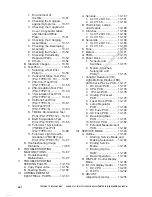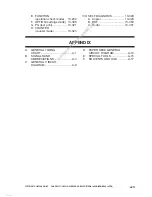
COPYRIGHT © 1999 CANON INC. CANON CLC1120/1130/1150 REV.0 MAR. 1999 PRINTED IN JAPAN (IMPRIME AU JAPON)
ii
Chapter 9
Externals/Auxiliary Mechanisms
shows the copier’s external parts, and
explains the principles used for the copier’s various control mechanisms in
view of the functions of electrical and mechanical units and in relation to
their timing of operation. It also shows how these units may be
disassembled/assembled and adjusted.
Chapter 10
Paper Deck
discusses the principles of operation used for the series of
operations between pickup and delivery performed by the paper deck. It
also explains the timing at which the various units involved are operated,
and shows how they may be disassembled/assembled and adjusted.
Chapter 11
Installation
introduces requirements for the site of installation, and shows
how the printer unit may be installed using step-by-step instructions.
Chapter 12
Maintenance and Servicing
provides tables of periodically replaced parts
and consumables/durables and scheduled servicing charts.
Chapter 13
Troubleshooting
provides tables of maintenance/inspection, standards/
adjustments, and problem identification (image fault/malfunction).
Appendix contains a general timing chart and general circuit diagrams.
The following rules apply throughout this Service Manual:
1.
Each chapter contains sections explaining the purpose of specific functions
and the relationship between electrical and mechanical systems with
reference to the timing of operation.
In the diagrams,
represents the path of mechanical drive where a
signal name accompanies the symbol
, the arrow indicates the direction
of the electric signal.
The expression “turn on the power” means flipping on the power switch,
closing the front door, and closing the delivery unit door, which results in
supplying the machine with power.
2.
In the digital circuits, ‘1’ is used to indicate that the voltage level of a given
signal is “High,” while ‘0’ is used to indicate “Low.” (The voltage value,
however, differs from circuit to circuit.) In addition, the asterisk (*) as in
“DRMD*” indicates that the DRMD signal goes on when ‘0’.
In practically all cases, the internal mechanisms of a microprocessor cannot
be checked in the field. Therefore, the operations of the microprocessors used
in the machines are not discussed: they are explained in terms of from sensors
to the input of the DC controller PCB and from the output of the DC controller
PCB to the loads.
The descriptions in this Service Manual are subject to change without notice for
product improvement or other purposes, and major changes will be communicated in the
form of Service Information bulletins.
All service persons are expected to have a good understanding of the contents of this
Service Manual and all relevant Service Information bulletins and be able to identify and
isolate faults in the machine.
fineline6
service-repairmanual.com




























